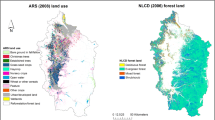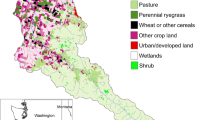Abstract
The flux of nitrogen in large rivers in North America and Europe is well explained as a function of the net anthropogenic inputs of nitrogen to the landscape, with on average 20 to 25% of these inputs exported in rivers and 75 to 80% of the nitrogen retained or denitrified in the landscape. Here, we use data for average riverine nitrogen fluxes and anthropogenic inputs of nitrogen over a 6-year period (1988–1993) for 16 major watersheds in the northeastern United States to examine if there is also a climatic influence on nitrogen fluxes in rivers. Previous studies have shown that for any given river, nitrogen fluxes are greater in years with higher discharge, but this can be interpreted as storage of nitrogen in the landscape during dry years and flushing of this stored nitrogen during wet years. Our analyses demonstrate that there is also a longer-term steady-state influence of climate on riverine nitrogen fluxes. Those watersheds that have higher precipitation and higher discharge export a greater fraction of the net anthropogenic inputs of nitrogen. This fractional export ranges from 10 to 15% of the nitrogen inputs in drier watersheds in the northeastern United States to over 35% in the wetter watersheds. We believe this is driven by lower rates of denitrification in the wetter watersheds, perhaps because shorter water residence times do not allow for as much denitrification in riparian wetlands and low-order streams. Using mean projections for the consequences of future climate change on precipitation and discharge, we estimate that nitrogen fluxes in the Susquehanna River to Chesapeake Bay may increase by 3 to 17% by 2030 and by 16 to 65% by 2095 due to greater fractional delivery of net anthropogenic nitrogen inputs as precipitation and discharge increase. Although these projections are highly uncertain, they suggest a need to better consider the influence of climate on riverine nitrogen fluxes as part of management efforts to control coastal nitrogen pollution.
Similar content being viewed by others
References
Aber J., McDowell W., Nadelhoffer K., Magill A., Berntson G., Kamakea M., McNulty S., Currie W., Rustad L., Fernandez I. (1998). Nitrogen saturation is temperate forest ecosystems. BioScience 48: 921–934
Aber J., Goodale C., Ollinger S.V., Smith M., Magill A.H., Martin M.E., Hallett R., Stoddard J.L. (2003). Is nitrogen deposition altering the nitrogen status of northeastern forests?. BioScience 53: 375–389
Alexander R.B., Johnes P.J., Boyer E.W., Smith R.A. (2002). A comparison of models for estimating the riverine export of nitrogen from large watersheds. Biogeochemistry 57/58: 295–339
Battaglin, W.A. and Goolsby, D.A. 1994. Spatial Data in Geographic Information System Format on Agricultural Chemical Use, Land Use, and Cropping Practices in the United States. USGS Water-Resources Investigations Report 94-4176 Report available online at http://water.usgs.gov/pubs/wri944176/. Data available on-line at http://water.usgs.gov/GIS/metadata/usgswrd/nit91.html
Boyer E.W., Goodale C.L., Jaworski N.A., Howarth R.W. (2002). Effects of anthropogenic nitrogen loading on riverine nitrogen export in the northeastern US. Biogeochemistry 57&58: 137–169
Bricker S.B., Clement C.G., Pirhalla D.E., Orland S.P., Farrow D.G.G. (1999). National Estuarine Eutrophication Assessment: A Summary of Conditions, Historical Trends, and Future Outlook. National Ocean Service National Oceanic and Atmospheric Administration, Silver Springs MD
Caraco N.F., Cole J.J. (1999). Human impact on nitrate export: An analysis using major world rivers. Ambio 28: 167–170
Cleveland C.C., Townsend A.R., Schimel D.S., Fisher H., Howarth R.W., Hedin L.O., Perakis S.S., Latty E.F., von Fischer J.C., Elseroad A., Wasson M.F. (1999). Global patterns of terrestrial biological nitrogen (N2) fixation in natural systems. Global Biogeochem. Cycles 13: 623–645
Cohn T.A., et al. (1992). The validity of a simple statistical model for estimating fluvial constituent loads: an empirical study involving loads entering the Chesapeake Bay. Water Resour Res 28: 2353–2363
*Environmental Protection Agency (2001). National Coastal Condition Report. EPA-620/R-01/005 Office of Research and Development and Office of Water U.S. Environmental Protection Agency, Washington DC
Galloway J.N., Dentener F.J., Capone D.G., Boyer E.W., Howarth R.W., Seitzinger S.P., Asner G.P., Cleveland C., Green P.A., Holland E., Karl D.M., Michaels A., Porter J.H., Townsend A., Vorosmarty C. (2004). Nitrogen cycles: past, present, and future. Biogeochemistry 70: 153–226
Hagy J.D, Boynton W.R., Keefe C.W., Wood K.V. (2004). Hypoxia in Chesapeake Bay, 1950–2001: Long-term change in relation to nutrient loading and river flow. Estuaries 27: 634–658
Holland E, Dentener F., Braswell B., Sulzman J. (1999). Contemporary and pre-industrial global reactive nitrogen budgets. Biogeochemistry 4:7–43
Howarth R.W. (1988). Nutrient limitation of net primary production in marine ecosystems. Annual Rev. Ecol. Systemat. 19: 89–110
Howarth, R.W. In press. The development of policy approaches for reducing nitrogen pollution to coastal waters of the USA. China Science
Howarth R.W., Jensen H., Marino R., Postma H. (1995). Transport to and processing of phosphorus in near-shore and oceanic waters. In: Tiessen H. (ed.), Phosphorus in the Global Environment, SCOPE #54. Wiley & Sons, Chichester, pp. 323–345
Howarth R.W., Billen G., Swaney D., Townsend A., Jaworski N., Lajtha K., Downing J.A., Elmgren R., Caraco N., Jordan T., Berendse F., Freney J., Kudeyarov V., Murdoch P., Zhu Zhao-liang. (1996). Riverine inputs of nitrogen to the North Atlantic Ocean: Fluxes and human influences. Biogeochemistry 35: 75–139
Howarth R.W., Anderson D., Cloern J., Elfring C., Hopkinson C., Lapointe B., Malone T., Marcus N., McGlathery K., Sharpley A., Walker D. (2000). Nutrient pollution of coastal rivers, bays, and seas. Issues Ecol. 7: 1–15
Howarth R.W., Boyer E.W., Pabich W.J., Galloway J.N. (2002a). Nitrogen use in the United States from 1961–200 and potential future trends. Ambio 31: 88–96
Howarth R., Walker D., Sharpley A. (2002b). Sources of nitrogen pollution to coastal waters of the United States. Estuaries 25:656–676
Howarth R.W., and Marino R. 2006. Nitrogen as the limiting nutrient for eutrophication in coastal marine ecosystems: Evolving views over 3 decades. Limnol. Oceanogr. 51:288–295
Howarth R.W., Ramakrishna K., Choi E., Elmgren R., Martinelli L., Mendoza A., Moomaw W., Palm C., Boy R., Scholes M., and Zhu Zhao-Liang. 2006. Chapter 9: Nutrient Management, Responses Assessment. Ecosystems and Human Well Being. Vol. 3, Policy Responses. The Millenium Ecosystem Assessment. Island Press, Washington, DC, pp. 295–311
Kittel T.G.F., Royle J.A., Daly C., Rosenbloom N.A., Gibson W.P., Fisher H.H., Schimel D.S., Berliner L.M., and VEMAP2 Participants. 1997. A gridded historical (1895–1993) bioclimate dataset for the conterminous United States. In: Reno N.V. (ed.), Proceedings of the 10th Conference on Applied Climatology
LewisW.M. 2002. Yield of nitrogenfrom minimally disturbedwatersheds of the United States.Biogeochemistry 57/58:375–385
Lewis W.M., Melack J.M.,McDowell W.H., McClain M.,andRichey J.E. 1999. Nitrogenyields from undisturbedwatersheds in the Americas.Biogeochemistry 46:149–162
Lovett G. and Lindberg SE (1993). Atmospheric deposition and canopy interactions of nitrogen in forests. Can. J. For. Res. 23: 1603–1616
Lovett GM, Rueth H (1999). Potential N mineralization and nitrification in American beech and sugar maple stands along a N deposition gradient in the northeastern US. Ecol. Appl. 9:1330–1344
Lovett G.M., Traynor M.M., Pouyal R.V., Carreiro M.M., Zhu W.X., Baxter J.W. (2000). Atmospheric deposition to oak forests along an urban-rural gradient. Env. Sci. Tech. 34: 4294–4300
McIsaac G.F., David M.B., Gertner G.Z., Goolsby D.A. (2001). Net anthropogenic N input to the Mississippi River basin and nitrate flux to the Gulf of Mexico. Nature 414: 166–167
Meyers T, Sickles J., Dennis R., Russell K., Galloway J., Church T. (2001). Atmospheric nitrogen deposition to coastal estuaries and their watersheds. In: Valigura R.A., Alexander R.B., Castro M.S., Meyers T.P., Paerl H.W., Stacey P.E., Turner R.E. (eds), Nitrogen Loading in Coastal Water Bodies: An Atmospheric Perspective. American Geophysical Union, Washington DC, pp. 53–76
Moore M.H., Pace M., Mather J., Murdoch P.S., Howarth R.W., Folt C.L., Chen C.Y., Hemond H.F., Flebbe P.A., Driscoll C.T. (1997). Potential effects of climate change on the freshwater ecosystems of the New England/mid-Atlantic region. Water Resources 11: 925–947
NADP. 2005. National Atmospheric Deposition Program/National Trends Network. NADP Program Office, Illinois State Water Survey, 2204 Griffith Dr., Champaign, IL 61820. [online] URL: http://nadp.sws.uiuc.edu/nadpdata
Najjar R.G. (1999). The water balance of the Susquehanna River basin and its response to climate change. J. Hydrol. 219: 7–19
Najjar R.G., Walker H.A., Anderson P.J., Barron E.J., Bord R.J., Gibson J.R., Kennedy V.S., Knight C.G., Megonigal J.P., O’Connor R.E., Polsky C.D., Psuty N.P., Richards B.A., Soreson L.G., Steele E.M., and Swanson R.S. (2000). The potential impacts of climate change on the mid-Atlantic coastal region. Climate Res. 14: 219–233
*NRC (2000). Clean Coastal Waters: Understanding and Reducing the Effects of Nutrient Pollution. National Academies Press, Washington, DC
Nixon S.W. (1995). Coastal marine eutrophication: a definition, social causes, and future concerns. Ophelia 41:199–219
Ollinger S.V., Aber J.D., Lovett G.M., Millham S.E., Lathrop R.G., Ellis J.M. (1993). A spatial model of atmospheric deposition for the northeastern U.S. Ecol. Appl. 3: 459–472
Prospero J.M., Barrett K., Church T., Dentener F., Duce R.A., Galloway J.N., Levy H., Moody J., Quinn P. (1996). Atmospheric deposition of nutrients to the North Atlantic Basin. Biogeochemistry 35: 27–73
Peierls B., Caraco N., Pace M., and Cole J.J. (1991). Human influence on river nitrogen. Nature 350:386–387
Randall G.W., Mulla D.J. (2001). Nitrate nitrogen in surface waters as influence by climatic conditions and agricultural practices. J. Environ. Qual. 30: 337–344
Randall G.W., Huggins D.R., Russelle M.P., Fuchs D.J., Nelson W.W., and Anderson J.L. (1997). Nitrate losses through subsurface tile drainage in CRP, alfalfa, and row crop systems. J. Environ. Qual. 26: 1240–1247
Scavia D., Field J.C., Boesch, Buddemeier R., Burkett V., Canyan D., Fogarty M., Harwell M.A., Howarth R.W., Mason C., Reed D.J., Royer T.C., Sallenger A.H., Titus J.G. (2002). Climate change impacts on US coastal and marine ecosystems. Estuaries 25: 149–164
Seitzinger S.P., Kroeze C. (1998). Global distribution of nitrous oxide production and N inputs in freshwater and coastal marine ecosystems. Global Biogeochem. Cycles 12: 93–113
Seitzinger S.P., Styles R.V., Boyer E.W., Alexander R., Billen G., Howarth R., Mayer B., van Breemen N. (2002). Nitrogen retention in rivers: model development and application to watersheds in the northeastern US. Biogeochemistry 57&58: 199–237
Smith S.V., Swaney D., Talaue-McManus L., Bartley J.D., Sandhei P.T., McLaughlin C.J., Dupra V.C., Crossland C.J., Buddemeier R.W., Maxwell B.A., Wulff F. (2003). Humans, hydrology, and thedistribution of inorganic nutrient loading to the ocean. BioScience 53: 235–245
Staver K.W., Brinsfield R.B. (1998). Use of cereal grain winter cover crops to reduce groundwater nitrate contamination in the Mid-Atlantic coastal plain. J. Soil Water Conserv. 53: 230–240
USGS. 2005. National Water Information System Data Retrieval [online] URL: http://waterdata. usgs.gov/nwis-w/US/
Van Breemen N., Boyer E.W., Goodale C.L., Jaworski N.A., Paustian K., Seitzinger S., Lajtha K., Mayer B., van Dam D., Howarth R.W., Nadelhoffer K.J., Eve M., Billen G. (2002). Where did all the nitrogen go? Fate of nitrogen inputs to large watersheds in the northeastern USA. Biogeochemistry 57&58: 267–293
Van Horn H.H. 1998. Factors affecting manure quantity, quality, and use. Proceedings of the Mid-South Ruminant Nutrition Conference, Dallas-Ft. Worth, May 7–8, 1998. Texas Animal Nutrition Council, pp 9–20
Wolock D.M., McCabe G.M. (1999). Simulated effects of climate change on mean annual runoff in the conterminous Unites States. J. Am. Wat. Res. Assoc. 35: 1341–1350
Acknowledgements
We thank Steven Ellner and Åsa Danielsson for helpful discussions of the statistical aspects of our analyses and Alan Townsend, Greg McIsaac, Sybil Seitzinger, and Ken Staver for comments on earlier drafts of the manuscript. This research was funded by grant R830882 from the EPA STAR program, by a USDA Hatch grant, and by an endowment provided to Cornell University by␣David R. Atkinson.
Author information
Authors and Affiliations
Corresponding author
Rights and permissions
About this article
Cite this article
Howarth, R., Swaney, D., Boyer, E. et al. The influence of climate on average nitrogen export from large watersheds in the Northeastern United States. Biogeochemistry 79, 163–186 (2006). https://doi.org/10.1007/s10533-006-9010-1
Accepted:
Published:
Issue Date:
DOI: https://doi.org/10.1007/s10533-006-9010-1




